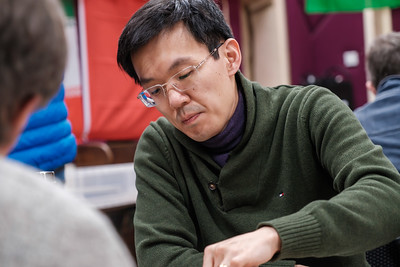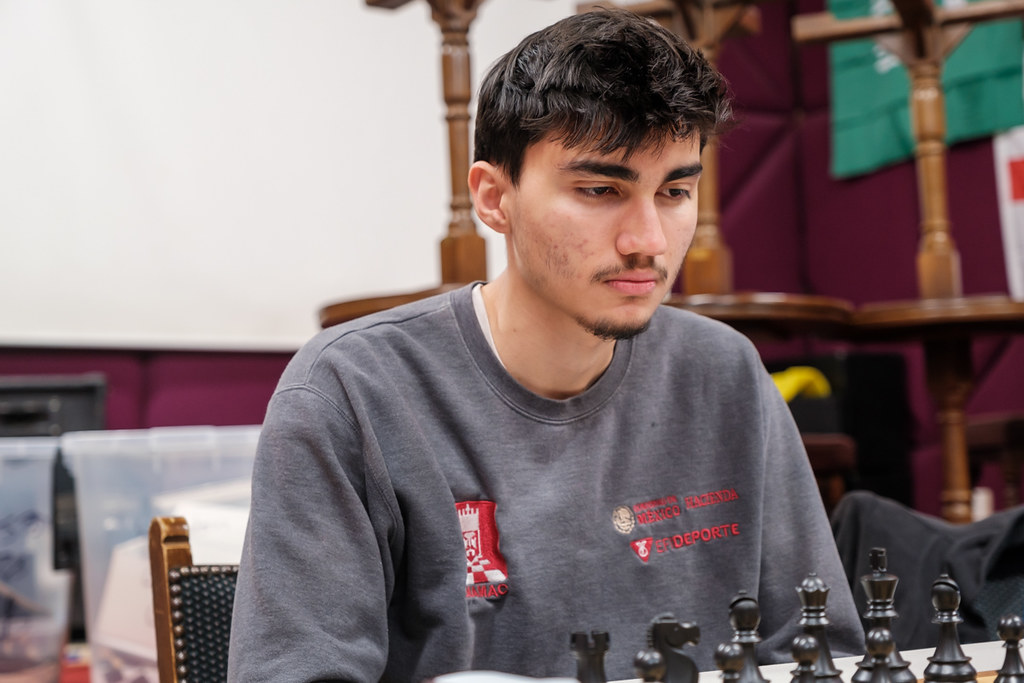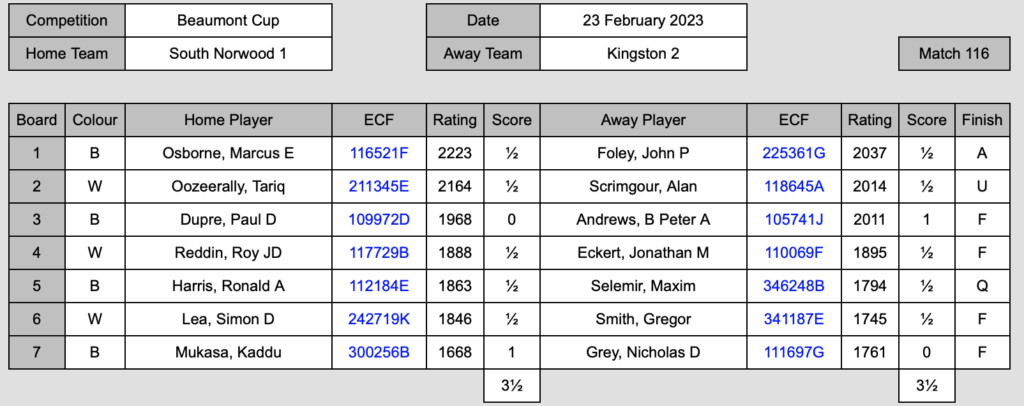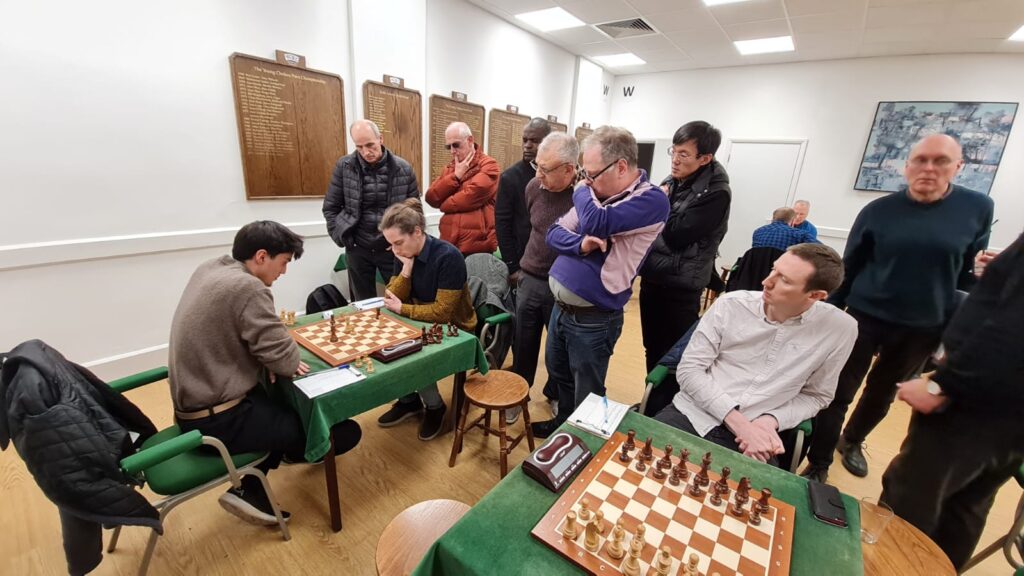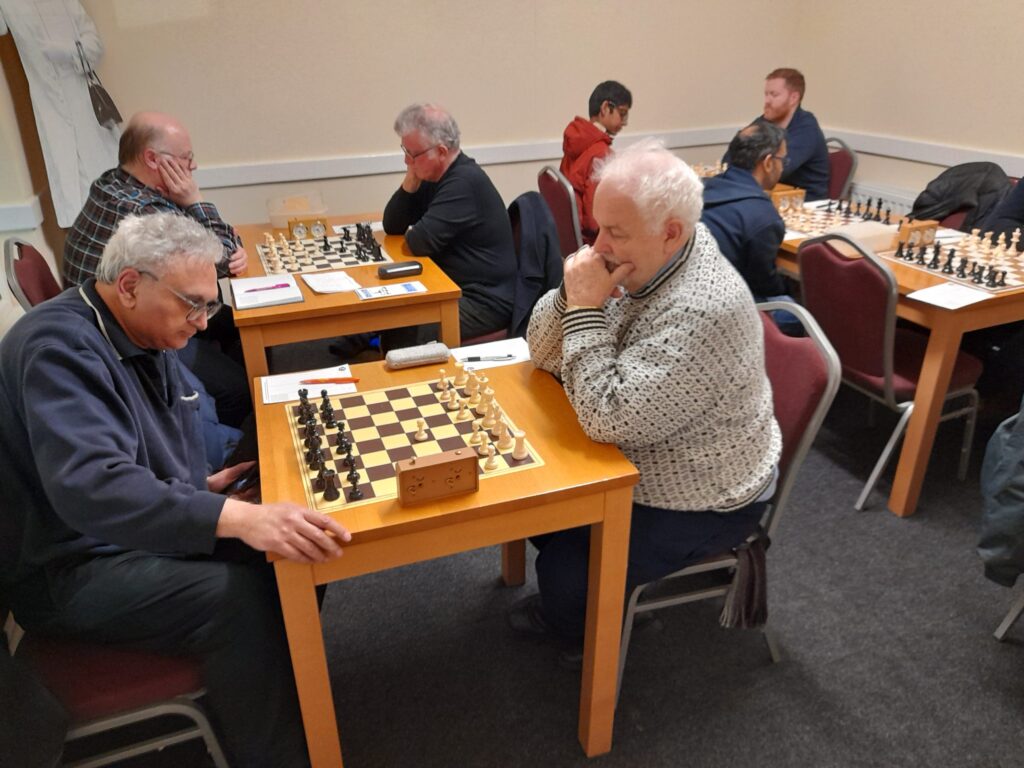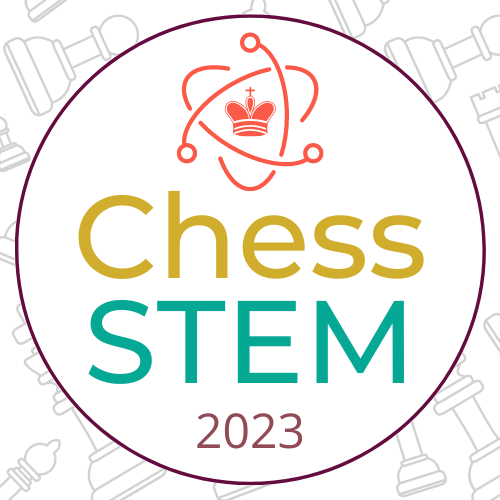Surrey League division 1 match played at the Willoughby Arms, Kingston on 13 March 2023
This was one of those banana skins. Kingston’s first team should be strong enough to defeat Guildford 2 with something to spare, but you never quite know. When the two teams met at Guildford last November Kingston only won narrowly, so captain David Rowson had no intention of being complacent and fielded a strong team against a Guildford eight that was packed with experience.
David, with Black, opened the scoring himself, beating Mike Morgan in a short and brutal game on board 5 that could have gone either way. Morgan chose the Potter Variation of the Scotch Game (1.e4 e5 2.Nf3 Nc6 3.d4 exd4 4.Nxd4 Bc5 5.Nb3) and played with great enterprise, advancing his a- and h-pawns and essaying an early lift of the rook on the a-file. This was the position after 13 moves. What should White play?
Morgan opted for the super-aggressive 14. g4. But because the black queen is so short of squares, the best move is 14. Rf4, after which White can establish a healthy advantage, as in this line: 14. Rf4 Bf5 15. g4 O-O-O 16. gxf5 Nxd5 17. Re4 Rhg8 18.Bg2 Kb8 19. O-O g6.
Morgan’s choice of 14. g4 led to an equal position and some very sharp play, but he lost his way in a blitz of tactics and the canny Rowson found the winning move in the position below.
22. Bxf2+! wins. The white king can’t recapture because Qh4+ would fork king and rook, winning the latter. But the alternative is just as bad, dropping the bishop on f1. Morgan resigned after Bxf2+ 23.Kd2 Rxe7 24.Qxe7 Qxf1. 1-0 to Kingston thanks to the captain’s cool head under fire and tactical awareness.
“At times it felt like edge-of-the-seat stuff,” David said after the game, “though the final part was quite tame as my opponent made some mistakes. I thought his opening was very impressive. People don’t usually play 5. Nb3 in the Scotch in my experience, but it looks terrifying for Black. White just advances the a- and h-pawns and can develop both his rooks along their files – amazing! 13… d6 by me was a mistake. I should have castled straightaway, though it still looks scary . He made it relatively easy after that, though I was pleased to find 22…Bxf2+.”
On board 1, Guildford’s James Toon was up against David Maycock and making a very good fist of it. David thought afterwards that he had tried too hard to unbalance the position, and he allowed the super-solid Toon to establish a small advantage, with an outside pawn in a rook-and-pawn endgame. David was as usual well behind on the clock and playing on the increment, but nevertheless played precisely to ensure a draw.
Peter Lalić’s game against Alex Warren on board 2 ended almost simultaneously and again produced a draw – an excellent result for the heavily outrated Warren, who was playing Black. Warren had the better of the opening in a closed Sicilian and developed an edge that led to Peter burning through his time – the control was 75 minutes plus a 10-second increment. With nine minutes left compared with 45 for Warren and Black still holding a small advantage, Peter offered a draw, which was accepted.
That made it 2-1 to Kingston, but things looked very promising elsewhere. On board 3, Vladimir Li said later that he felt Guildford captain Julien Shepley was positionally lost relatively early in the game. But after winning the exchange it took him until the 54th move to deliver mate as Shepley clung on. 3-1 to Kingston.
Max Selemir, making his first-team debut, nonchalantly sac’d a bishop against Peter Horlock in the position below.
The sac proved to be completely sound, Max quickly getting the piece back with interest: 15. Bxh6 gxh6 16. Qxh6 Nh7 17. Re3 d5 18. Rg3+ Bg5 19. Qxc6 bxc6 20. h4 d4 21. Ne2 Rde8 22. f3 f6 23. hxg5 fxg5. He then quickly mopped up his opponent’s disorganised pawns and won in good style. A great start to his first-team career.
That made it 4-1 and Peter Andrews, with Black against Rory Davies, soon took Kingston over the line with a smooth win. He accepted Davies’s Queen’s Gambit, and said afterwards that a recent experience as a spectator at the annual Varsity Match had greatly aided his cause. “I owe the slight plus I got from the opening to having attended the Oxford v Cambridge match a couple of weeks ago,” he explained. “Freddie Hand, the Cambridge board 3, played the Queen’s Gambit Accepted and this line came up. He played Nc6 (after c5) rather than Nd7, got a bad position fairly quickly and lost. In the commentary room, Matthew Sadler opined that black’s knight was misplaced on c6; it was blocking the action of the queen’s bishop, vulnerable on the c-file, and from d7 the knight can go to more useful squares – in particular b6-c4. So I followed that advice, and it turned out right. The advice might be equally good for White, but it’s psychologically hard not to play Nc3 to support a possible d5 break.”
There were two games still in progress: Alan Scrimgour against Trevor Jones on board 6 and Will Taylor against Phil Stimpson on board 4. Alan played the Panov-Botvinnik Attack against Jones’s Caro-Kann, fixing a knight on b6 protected by a pawn on c5 that horribly restricted Black’s play. He lined up his queen and both rooks on the e-file, established a stranglehold on the position, won material and created a passed a-pawn. 6-1.
That left Will’s game, the only one of the evening being determined – at Will’s opponent’s choice – by adjudication rather than to a finish (when, oh when, will the Surrey League get rid of adjudications?). Stimpson played a Scandinavian; Will made most of the running and gained an edge; but he missed a win on move 26 when he could have won a piece by exploiting a back-rank mating threat; and the final position, though appearing to favour Will because he has an extra pawn on the a-file in a rook-and-pawn endgame, has been adjudged a draw. Engines may say he is +1, but, as so often in rook-and-pawn endgames with long horizons, engines are wrong.
As ever, Will took the failure to convert philosophically. What an admirable temperament he has. And at least he – and the rest of the team – had the consolation of a 6.5-1.5 victory that leaves Kingston proudly top of the Surrey League division one table with six wins in six matches and needing only half a point more from the final two matches – tricky away trips to Wimbledon and Coulsdon – to secure the club’s first Surrey Trophy (division 1) title since 1975. The ginger beer is on ice.
Stephen Moss


